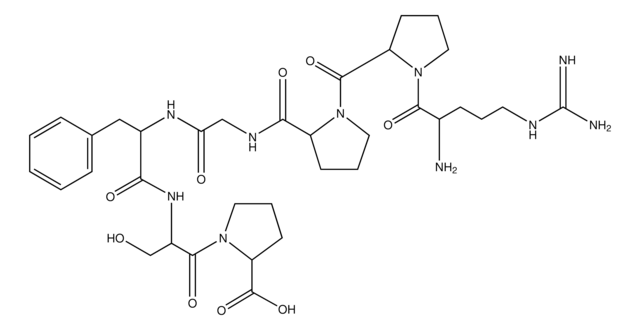50199
Gly-Gly
≥99.5% (NT), BioUltra
Synonym(e):
Diglycin, Glycylglycin
About This Item
product name
Gly-Gly, BioUltra, ≥99.5% (NT)
Produktlinie
BioUltra
Assay
≥99.5% (NT)
Form
powder
Verunreinigungen
insoluble matter, passes filter test
Glührückstand
≤0.05% (as SO4)
Verlust
≤0.05% loss on drying, 110 °C
Farbe
white
pH-Wert
4.5-6.0 (20 °C, 1 M in H2O)
Nützlicher pH-Bereich
7.5-8.9
pKa (25 °C)
8.2
mp (Schmelzpunkt)
220-240 °C
Löslichkeit
H2O: 1 M at 20 °C, clear, colorless
Anionenspuren
chloride (Cl-): ≤50 mg/kg
sulfate (SO42-): ≤50 mg/kg
Kationenspuren
Al: ≤5 mg/kg
As: ≤0.1 mg/kg
Ba: ≤5 mg/kg
Bi: ≤5 mg/kg
Ca: ≤10 mg/kg
Cd: ≤5 mg/kg
Co: ≤5 mg/kg
Cr: ≤5 mg/kg
Cu: ≤5 mg/kg
Fe: ≤5 mg/kg
K: ≤50 mg/kg
Li: ≤5 mg/kg
Mg: ≤5 mg/kg
Mn: ≤5 mg/kg
Mo: ≤5 mg/kg
NH4+: ≤200 mg/kg
Na: ≤50 mg/kg
Ni: ≤5 mg/kg
Pb: ≤5 mg/kg
Sr: ≤5 mg/kg
Zn: ≤5 mg/kg
λ
1 M in H2O
UV-Absorption
λ: 260 nm Amax: 0.075
λ: 280 nm Amax: 0.072
SMILES String
NCC(=O)NCC(O)=O
InChI
1S/C4H8N2O3/c5-1-3(7)6-2-4(8)9/h1-2,5H2,(H,6,7)(H,8,9)
InChIKey
YMAWOPBAYDPSLA-UHFFFAOYSA-N
Angaben zum Gen
human ... SLC15A1(6564)
Suchen Sie nach ähnlichen Produkten? Aufrufen Leitfaden zum Produktvergleich
Anwendung
- Structural and molecular insights into a bifunctional glycoside hydrolase 30 xylanase specific to glucuronoxylan: This study provides a detailed analysis of the enzyme′s structure and function, demonstrating D-(+)-Xylose′s role in enhancing our understanding of xylose metabolism in industrial applications such as biofuel production and biotechnological innovations (Pentari et al., 2024).
- Efficient production of 1,2,4-butanetriol from corn cob hydrolysate by metabolically engineered Escherichia coli: Highlights the utilization of D-(+)-Xylose from agricultural waste, optimizing processes for sustainable biofuel production, emphasizing the sugar′s pivotal role in renewable energy research (Li et al., 2024).
- Biochemical characterization of a xylose-tolerant GH43 β-xylosidase from Geobacillus thermodenitrificans: Provides insights into the enzyme′s biophysical properties and its utility in biotechnological applications, furthering the understanding of D-(+)-Xylose′s role in enhancing enzyme performance under various industrial conditions (Melo et al., 2023).
- Genome-scale metabolic modeling reveals metabolic trade-offs associated with lipid production in Rhodotorula toruloides: Explores how D-(+)-Xylose can be used to optimize metabolic pathways for improved lipid production, highlighting its potential in synthetic biology and metabolic engineering to enhance bioproduct synthesis efficiency (Reķēna et al., 2023).
Sonstige Hinweise
Lagerklassenschlüssel
11 - Combustible Solids
WGK
WGK 3
Flammpunkt (°F)
Not applicable
Flammpunkt (°C)
Not applicable
Persönliche Schutzausrüstung
dust mask type N95 (US), Eyeshields, Gloves
Analysenzertifikate (COA)
Suchen Sie nach Analysenzertifikate (COA), indem Sie die Lot-/Chargennummer des Produkts eingeben. Lot- und Chargennummern sind auf dem Produktetikett hinter den Wörtern ‘Lot’ oder ‘Batch’ (Lot oder Charge) zu finden.
Besitzen Sie dieses Produkt bereits?
In der Dokumentenbibliothek finden Sie die Dokumentation zu den Produkten, die Sie kürzlich erworben haben.
Kunden haben sich ebenfalls angesehen
Unser Team von Wissenschaftlern verfügt über Erfahrung in allen Forschungsbereichen einschließlich Life Science, Materialwissenschaften, chemischer Synthese, Chromatographie, Analytik und vielen mehr..
Setzen Sie sich mit dem technischen Dienst in Verbindung.

